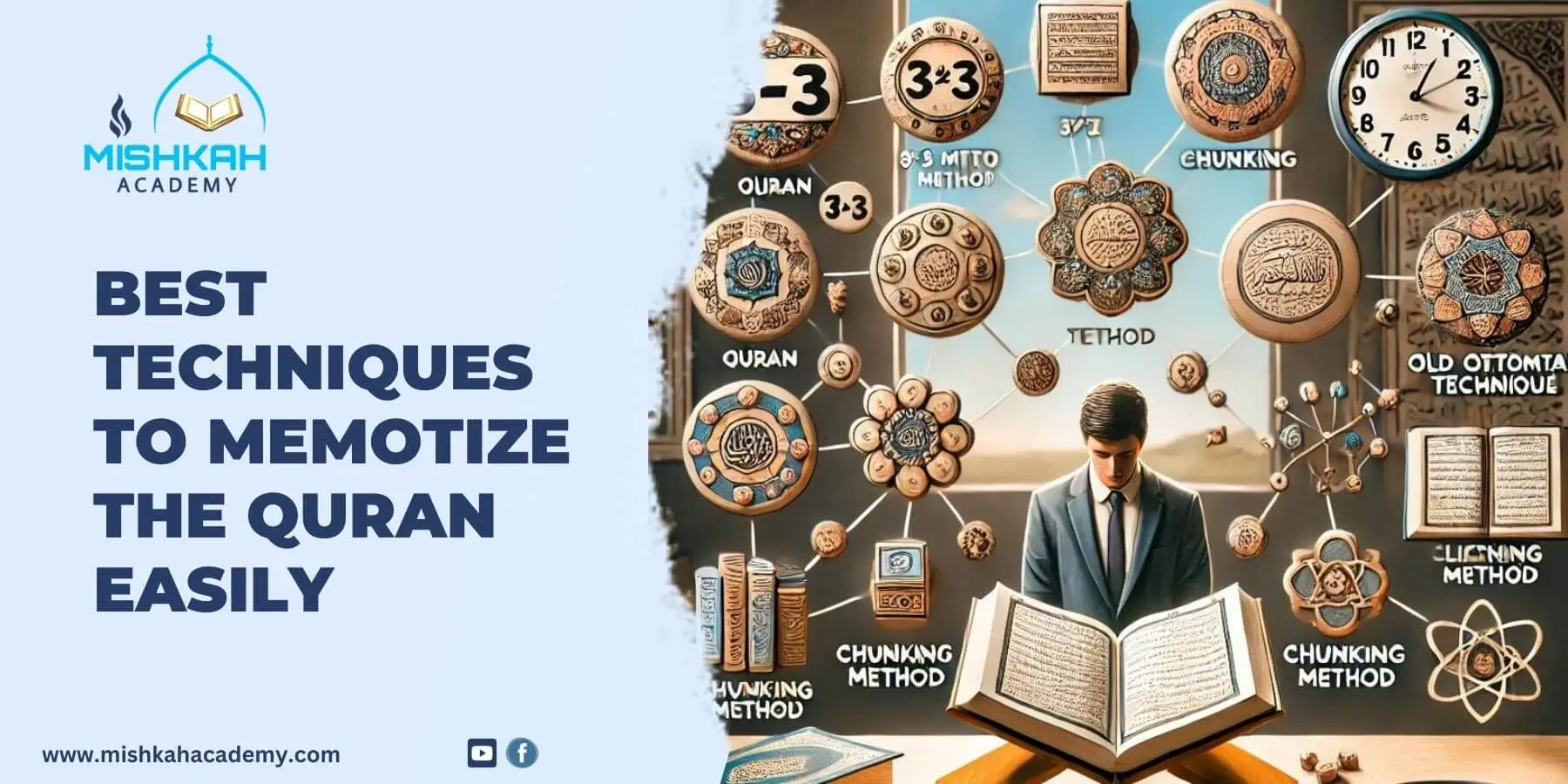Knowing at least a couple of sound Quran memorization techniques is crucial to completing your Hifz on time. Often, Huffaz struggles with sticking with one technique and juggling between many, which complicates their Hifz journey. However, those who know and employ the best Quran memorization techniques end up achieving their goal in the most ideal way possible.
The best methods include the 3×3 method of memorizing the Quran, the 3:10 Hifz technique, the old Ottoman method, memorizing from bottom to top, writing down each ayah while memorizing, and more.
10 Best Quran Memorization Techniques
Table of Contents
ToggleLet’s break down each method into easy steps to enhance your understanding.
1. Follow the 3×3 Method of Memorizing the Quran
One effective Quran memorization technique is the 3×3 method, which provides a structured and focused approach. It begins with reciting a selected portion 5-7 times, ensuring familiarity. Then, each verse is recited three times, with the second verse repeated the same way. Afterward, both are recited together three times.
This method builds a solid connection between verses, aiding retention. Developed by Qari Wisam Sharieff, the 3×3 method ensures gradual progress while committing the lesson to memory. Once you consistently apply this technique, memorizing becomes easier and more organized, making it ideal for anyone on their Hifz journey. Mishkah Academy tutors use this method in their online hifz course for fast memorization.
2. 3:10 Hifz Technique
The 3:10 Hifz technique simplifies Quran memorization into easy steps. Start by reading the first verse 10 times while looking at the Quran. Once you’re comfortable, recite that verse from memory three times. Then, move on to the next verse. Repeat the same process: read it 10 times while looking, then recite it thrice from memory.
Continue following these steps for each verse until you’ve completed the entire page. This structured method ensures deep familiarity with each verse, making memorization smoother and more effective by reinforcing learning with repetition and recitation.
3. Using the Old Ottoman Technique of Memorizing
The Old Ottoman technique of memorizing the Quran has roots in traditional Turkish methods. It involves starting from the last page of Juz 1 and moving backward through the Quran. After completing Juz 1’s final page, students proceed to the last page of Juz 2, continuing this pattern until they reach the last page of Juz 30. This technique helps in building a gradual understanding of the Quran, and memorizing from the end ensures that earlier learned sections are always reviewed.
Historically, this method was used by Ottoman scholars to help students complete their Hifz efficiently, as it emphasizes repetition and steady progress, ensuring a deep connection with the Quran throughout the journey.
4. Memorizing from Bottom-to-Top
The Bottom-to-Top memorization technique offers a unique approach to learning the Quran. You start by focusing on the last line of a page and work your way upwards, which provides a different challenge to your memory. This method helps reinforce the memorization of the last part of each page first, ensuring it is well-remembered before moving on to the next section.
Begin by reading the last line of the page multiple times until it is memorized. Once comfortable, move to the second-to-last line and repeat the process. Continue this pattern, working up the page until you reach the top. Review the entire page from bottom to top, ensuring each line is firmly memorized before proceeding.
Note: Mishkah academy tutors mostly used this method in intensive hifz program for students to remember the noble Quran in short period of time.
5. Reading 1 Ayah 15 Times to Memorize
Reading one Ayah 15 times is a focused technique to aid memorization. This method involves repeating the Ayah multiple times until it is firmly committed to memory. Consistent repetition ensures deep retention and understanding.
The Prophet Muhammad (peace be upon him) emphasized the importance of memorizing the Quran in a hadith:
“The best of you are those who learn the Quran and teach it” (Sahih al-Bukhari, 5027).
6. Writing Down Each Ayah for Memorization
Writing down the ayahs when memorizing is also a sound technique. Here’s how you can achieve it:
- Write down the Ayah you want to memorize on a piece of paper.
- Read the written Ayah aloud several times, focusing on its meaning.
- Repeat the process by writing the Ayah down again from memory.
- Compare your written Ayah with the original text to check for accuracy.
- Review the Ayah you’ve written throughout the day.
- Practice writing the Ayah down multiple times until you can write it correctly from memory.
- Regularly review previously written Ayahs to reinforce memorization.
7. Using the Chunking Method to Memorize
The chunking method breaks down long Ayahs into smaller, manageable parts or “chunks.” Start by dividing the Ayah into a few sections. Memorize each chunk separately, repeating it until you remember it well. Once you’ve mastered all chunks, practice putting them together. This technique helps manage complex Ayahs by focusing on one part at a time, making memorization more organized and less overwhelming.
8. Listening to Ayahs on Repeat
Listening to Ayahs repeatedly helps with memorization by reinforcing the verses through auditory repetition. Play the Ayah you want to memorize multiple times a day. Focus on listening closely and repeating it along with the recording. This method aids in memorizing by strengthening your ability to recall the Ayah through sound. It’s a helpful way to reinforce what you’ve learned and improve retention.
9. Recite Out Aloud and Rehearse
Reciting Ayahs aloud is an effective memorization technique. Start by reading the Ayah out loud several times to become familiar with it. Then, recite it from memory as often as possible. Regularly rehearse aloud, including during prayer or while walking, to enhance memorization.
This method helps reinforce the Ayah in your memory and improves fluency. Allah says,
10. Using the Mind Mapping Technique
Mind mapping helps with memorization by creating a visual representation of the Ayah. Start by writing the main idea of the Ayah in the center of a page. Draw branches for each key part or theme of the Ayah, connecting them to the main idea.
Use colors or symbols to make it visually engaging. This technique helps organize and visualize information, making it easier to remember and recall the Ayah.
Conclusion
Mastering Quran memorization requires using effective techniques tailored to your learning style. Whether it’s through chunking, listening, reciting aloud, or mind mapping, each method offers unique benefits.
For those seeking expert guidance, Mishkah Academy stands out as the best source. With a team of experienced Hifz tutors, Mishkah Academy provides personalized support to help students from the UK, USA, Canada, Australia, Germany, and across Europe learn Quran online at home effectively. By employing these techniques and seeking expert help, you can achieve your memorization goals with confidence.






